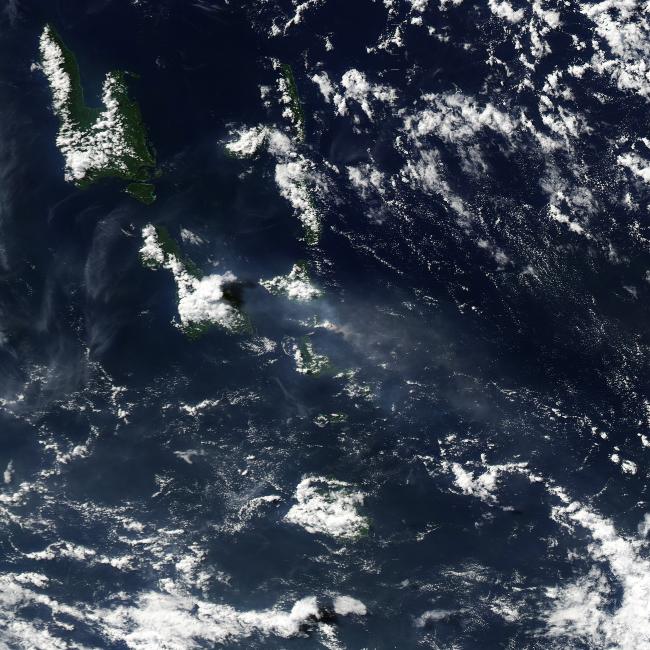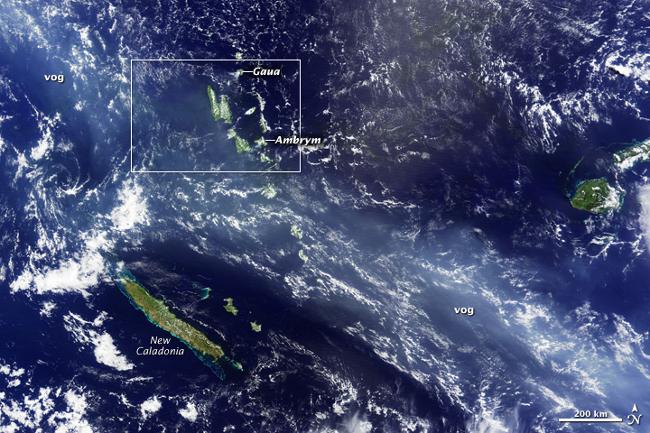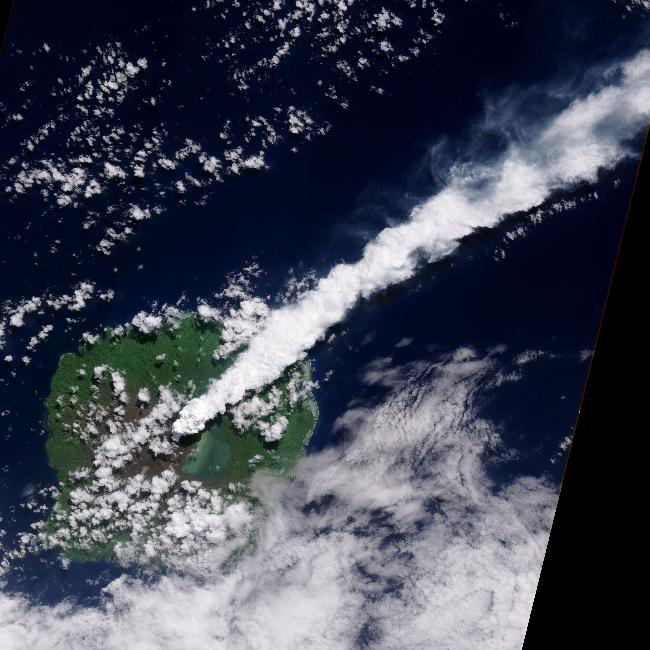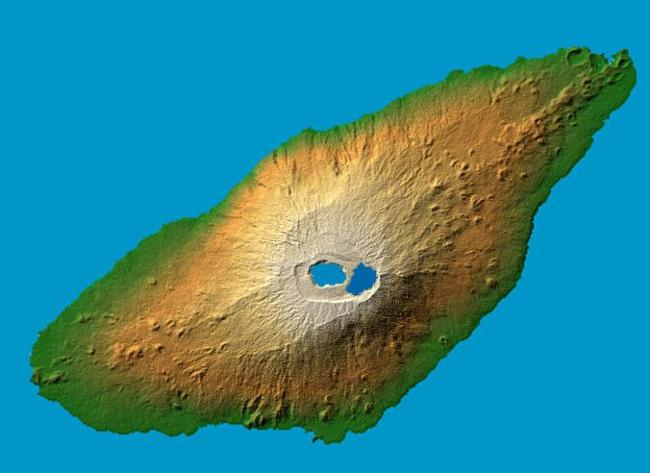Introduction :: VANUATU
-
Multiple waves of colonizers, each speaking a distinct language, migrated to the New Hebrides in the millennia preceding European exploration in the 18th century. This settlement pattern accounts for the complex linguistic diversity found on the archipelago to this day. The British and French, who settled the New Hebrides in the 19th century, agreed in 1906 to an Anglo-French Condominium, which administered the islands until independence in 1980, when the new name of Vanuatu was adopted.
Geography :: VANUATU
-
Oceania, group of islands in the South Pacific Ocean, about three-quarters of the way from Hawaii to Australia
16 00 S, 167 00 E
Oceania
total: 12,189 sq km
land: 12,189 sq km
water: 0 sq km
note: includes more than 80 islands, about 65 of which are inhabited
country comparison to the world: 164
slightly larger than Connecticut
0 km
2,528 km
measured from claimed archipelagic baselines
territorial sea: 12 nm
contiguous zone: 24 nm
exclusive economic zone: 200 nm
continental shelf: 200 nm or to the edge of the continental margin
tropical; moderated by southeast trade winds from May to October; moderate rainfall from November to April; may be affected by cyclones from December to April
mostly mountainous islands of volcanic origin; narrow coastal plains
mean elevation: NA
elevation extremes: lowest point: Pacific Ocean 0 m
highest point: Tabwemasana 1,877 m
manganese, hardwood forests, fish
agricultural land: 15.3%
arable land 1.6%; permanent crops 10.3%; permanent pasture 3.4%
forest: 36.1%
other: 48.6% (2011 est.)
0 sq km (2012)
tropical cyclones or typhoons (January to April); volcanic eruption on Aoba (Ambae) island began on 27 November 2005, volcanism also causes minor earthquakes; tsunamis
volcanism: significant volcanic activity with multiple eruptions in recent years; Yasur (elev. 361 m), one of the world's most active volcanoes, has experienced continuous activity in recent centuries; other historically active volcanoes include, Aoba, Ambrym, Epi, Gaua, Kuwae, Lopevi, Suretamatai, and Traitor's Head
most of the population does not have access to a reliable supply of potable water; deforestation
party to: Antarctic-Marine Living Resources, Biodiversity, Climate Change, Climate Change-Kyoto Protocol, Desertification, Endangered Species, Law of the Sea, Marine Dumping, Ozone Layer Protection, Ship Pollution, Tropical Timber 94
signed, but not ratified: none of the selected agreements
a Y-shaped chain of four main islands and 80 smaller islands; several of the islands have active volcanoes and there are several underwater volcanoes as well
People and Society :: VANUATU
-
277,554 (July 2016 est.)
country comparison to the world: 183
noun: Ni-Vanuatu (singular and plural)
adjective: Ni-Vanuatu
Ni-Vanuatu 97.6%, part Ni-Vanuatu 1.1%, other 1.3% (2009 est.)
local languages (more than 100) 63.2%, Bislama (official; creole) 33.7%, English (official) 2%, French (official) 0.6%, other 0.5% (2009 est.)
Protestant 70% (includes Presbyterian 27.9%, Anglican 15.1%, Seventh Day Adventist 12.5%, Assemblies of God 4.7%, Church of Christ 4.5%, Neil Thomas Ministry 3.1%, and Apostolic 2.2%), Roman Catholic 12.4%, customary beliefs 3.7% (including Jon Frum cargo cult), other 12.6%, none 1.1%, unspecified 0.2% (2009 est.)
0-14 years: 36.11% (male 51,160/female 49,073)
15-24 years: 20% (male 27,559/female 27,939)
25-54 years: 34.74% (male 47,189/female 49,244)
55-64 years: 5.27% (male 7,327/female 7,297)
65 years and over: 3.88% (male 5,470/female 5,296) (2016 est.)
population pyramid:

Australia-Oceania
::VANUATU

Population Pyramid
A population pyramid illustrates the age and sex structure of a country's population and may provide insights about political and social stability, as well as economic development. The population is distributed along the horizontal axis, with males shown on the left and females on the right. The male and female populations are broken down into 5-year age groups represented as horizontal bars along the vertical axis, with the youngest age groups at the bottom and the oldest at the top. The shape of the population pyramid gradually evolves over time based on fertility, mortality, and international migration trends.
For additional information, please see the entry for Population pyramid on the Definitions and Notes page under the References tab.
total dependency ratio: 68.7%
youth dependency ratio: 61.6%
elderly dependency ratio: 7.1%
potential support ratio: 14.1% (2015 est.)
total: 21.7 years
male: 21.3 years
female: 22.1 years (2016 est.)
country comparison to the world: 179
1.9% (2016 est.)
country comparison to the world: 53
24.5 births/1,000 population (2016 est.)
country comparison to the world: 54
4.1 deaths/1,000 population (2016 est.)
country comparison to the world: 208
-1.4 migrant(s)/1,000 population (2016 est.)
country comparison to the world: 153
urban population: 26.1% of total population (2015)
rate of urbanization: 3.42% annual rate of change (2010-15 est.)
PORT-VILA (capital) 53,000 (2014)
at birth: 1.05 male(s)/female
0-14 years: 1.04 male(s)/female
15-24 years: 0.99 male(s)/female
25-54 years: 0.96 male(s)/female
55-64 years: 1 male(s)/female
65 years and over: 1.04 male(s)/female
total population: 1 male(s)/female (2016 est.)
78 deaths/100,000 live births (2015 est.)
country comparison to the world: 68
total: 15.1 deaths/1,000 live births
male: 16.1 deaths/1,000 live births
female: 14 deaths/1,000 live births (2016 est.)
country comparison to the world: 103
total population: 73.4 years
male: 71.8 years
female: 75.1 years (2016 est.)
country comparison to the world: 131
3.16 children born/woman (2016 est.)
country comparison to the world: 52
38.4% (2007)
5% of GDP (2014)
country comparison to the world: 171
0.12 physicians/1,000 population (2008)
1.8 beds/1,000 population (2008)
improved:
urban: 98.9% of population
rural: 92.9% of population
total: 94.5% of population
unimproved:
urban: 1.1% of population
rural: 7.1% of population
total: 5.5% of population (2015 est.)
improved:
urban: 65.1% of population
rural: 55.4% of population
total: 57.9% of population
unimproved:
urban: 34.9% of population
rural: 44.6% of population
total: 42.1% of population (2015 est.)
NA
NA
NA
32.9% (2014)
country comparison to the world: 39
10.7% (2013)
country comparison to the world: 62
4.9% of GDP (2014)
country comparison to the world: 79
definition: age 15 and over can read and write
total population: 85.2%
male: 86.6%
female: 83.8% (2015 est.)
total: 10.6%
male: 10.2%
female: 11.2% (2009 est.)
Government :: VANUATU
-
conventional long form: Republic of Vanuatu
conventional short form: Vanuatu
local long form: Ripablik blong Vanuatu
local short form: Vanuatu
former: New Hebrides
etymology: derived from the words "vanua" (home or land) and "tu" (stand) that occur in several of the Austonesian languages spoken on the islands and which provide the meaning of "independence" or the sense of "our land"
parliamentary republic
name: Port-Vila (on Efate)
geographic coordinates: 17 44 S, 168 19 E
time difference: UTC+11 (16 hours ahead of Washington, DC, during Standard Time)
6 provinces; Malampa, Penama, Sanma, Shefa, Tafea, Torba
30 July 1980 (from France and the UK)
Independence Day, 30 July (1980)
effective 30 July 1980; amended several times, last in 2013 (2016)
mixed legal system of English common law, French law, and customary law
has not submitted an ICJ jurisdiction declaration; accepts ICCt jurisdiction
citizenship by birth: no
citizenship by descent only: both parents must be citizens of Vanuatu; in the case of only one parent, it must be the father who is a citizen
dual citizenship recognized: no
residency requirement for naturalization: 10 years
18 years of age; universal
chief of state: President Baldwin LONSDALE (since 22 September 2014)
head of government: Prime Minister Charlot SALWAI (since 11 February 2016)
cabinet: Council of Ministers appointed by the prime minister, responsible to parliament
elections/appointments: president indirectly elected by an electoral college consisting of Parliament and presidents of the 6 provinces; Vanuatu president serves a 5-year term; election last held on 17 September 2014 (next to be held in 2019); following legislative elections, the leader of the majority party or majority coalition usually elected prime minister by parliament from among its members; election for prime minister last held on 11 February 2016 (next to be held following general elections in 2020)
election results: Baldwin LONSDALE (independent) elected president; Parliament vote - 46 out of 52 on the eighth ballot; Charlot SALWAI elected prime minister on 11 February 2016 with 46 votes
description: unicameral Parliament (52 seats; members directly elected in multi-seat constituencies by simple majority vote to serve 4-year terms)
note: the National Council of Chiefs advises on matters of culture and language
elections: last held on 22 January 2016 (next to be held in 2020)
election results: percent of vote by party - NA; seats by party - VP 8, PPP 6, UMP 5, GJP 4, NUP 4, IG 3, GC 3, NAG 3, RMC 3, MPP 2, NIPDP 2, PSP 1, VLDP 1, VNP 1, VPDP 1, VRP 1, and independent 4; note - political party associations are fluid
.highest court(s): Supreme Court (consists of the chief justice and 6 justices - 3 local and 4 expatriate); note - appeals beyond the Supreme Court are considered by the Court of Appeal, constituted by 2 or more judges of the Supreme Court sitting together
judge selection and term of office: Supreme Court chief justice appointed by the president after consultation with the prime minister and the leader of the opposition; other judges are appointed by the president on the advice of the Judicial Service Commission, a 4-member advisory body; judges appointed until age of retirement
subordinate courts: Magistrates Courts; Island Courts
Greens Confederation or GC [Moana CARCASSES Kalosil]
Iauko Group or IG [Tony NARI]
Land and Justice Party (Graon mo Jastis Pati) or GJP [Ralph REGENVANU]
Melanesian Progressive Party or MPP [Barak SOPE]
Nagriamel movement or NAG [Frankie STEVENS]
Natatok Indigenous People's Democratic Party or (NATATOK) or NIPDP [Alfred Roland CARLOT]
National United Party or NUP [Ham LINI]
People's Progressive Party or PPP [Sato KILMAN]
People's Service Party or PSP [Don KEN]
Reunification of Movement for Change or RMC [Charlot SALWAI]
Union of Moderate Parties or UMP [Serge VOHOR]
Vanua'aku Pati (Our Land Party) or VP [Edward NATAPEI]
Vanuatu Democratic Party [Maxime Carlot KORMAN]
Vanuatu Liberal Democratic Party or VLDP [Tapangararua WILLIE]
Vanuatu National Party or VNP [Issac HAMARILIU]
Vanuatu National Development Party or VNDP [Robert Bohn SIKOL]
Vanuatu Republican Party or VRP [Marcellino PIPITE]
NA
ACP, ADB, AOSIS, C, FAO, G-77, IBRD, ICAO, ICRM, IDA, IFC, IFRCS, ILO, IMF, IMO, IMSO, IOC, IOM, ITU, ITUC (NGOs), MIGA, NAM, OAS (observer), OIF, OPCW, PIF, Sparteca, SPC, UN, UNCTAD, UNESCO, UNIDO, UNWTO, UPU, WCO, WFTU (NGOs), WHO, WIPO, WMO, WTO
Vanuatu does not have an embassy in the US; it does, however, have a Permanent Mission to the UN
the US does not have an embassy in Vanuatu; the US Ambassador to Papua New Guinea is accredited to Vanuatu
two equal horizontal bands of red (top) and green with a black isosceles triangle (based on the hoist side) all separated by a black-edged yellow stripe in the shape of a horizontal Y (the two points of the Y face the hoist side and enclose the triangle); centered in the triangle is a boar's tusk encircling two crossed namele fern fronds, all in yellow; red represents the blood of boars and men, as well as unity, green the richness of the islands, and black the ni-Vanuatu people; the yellow Y-shape - which reflects the pattern of the islands in the Pacific Ocean - symbolizes the light of the Gospel spreading through the islands; the boar's tusk is a symbol of prosperity frequently worn as a pendant on the islands; the fern fronds represent peace
note: one of several flags where a prominent component of the design reflects the shape of the country; other such flags are those of Bosnia and Herzegovina, Brazil, and Eritrea
boar's tusk with crossed fern fronds; national colors: red, black, green, yellow
name: "Yumi, Yumi, Yumi" (We, We, We)
lyrics/music: Francois Vincent AYSSAV
note: adopted 1980; the anthem is written in Bislama, a Creole language that mixes Pidgin English and French
Economy :: VANUATU
-
This South Pacific island economy is based primarily on small-scale agriculture, which provides a living for about two-thirds of the population. Fishing, offshore financial services, and tourism, with nearly 197,000 visitors in 2008, are other mainstays of the economy. Australia and New Zealand are the main source of tourists and foreign aid. A small light industry sector caters to the local market. Tax revenues come mainly from import duties. Mineral deposits are negligible; the country has no known petroleum deposits.
Economic development is hindered by dependence on relatively few commodity exports, vulnerability to natural disasters, and long distances from main markets and between constituent islands. In response to foreign concerns, the government has promised to tighten regulation of its offshore financial center.
Since 2002, the government has stepped up efforts to boost tourism through improved air connections, resort development, and cruise ship facilities. Agriculture, especially livestock farming, is a second target for growth.
$723 million (2016 est.)
$695.2 million (2015 est.)
$700.8 million (2014 est.)
note: data are in 2016 dollars
country comparison to the world: 207
$773 million (2015 est.)
4% (2016 est.)
-0.8% (2015 est.)
2.3% (2014 est.)
country comparison to the world: 59
$2,600 (2016 est.)
$2,600 (2015 est.)
$2,700 (2014 est.)
note: data are in 2016 dollars
country comparison to the world: 195
household consumption: 67%
government consumption: 17.6%
investment in fixed capital: 28.6%
investment in inventories: 0%
exports of goods and services: 37.3%
imports of goods and services: -50.5% (2016 est.)
agriculture: 26%
industry: 9%
services: 65% (2016 est.)
copra, coconuts, cocoa, coffee, taro, yams, fruits, vegetables; beef; fish
food and fish freezing, wood processing, meat canning
4% (2016 est.)
country comparison to the world: 59
115,900 (2007 est.)
country comparison to the world: 180
agriculture: 65%
industry: 5%
services: 30% (2000 est.)
1.7% (1999 est.)
country comparison to the world: 9
NA%
lowest 10%: NA%
highest 10%: NA%
revenues: $175.9 million
expenditures: $201.3 million (2016 est.)
22.8% of GDP (2016 est.)
country comparison to the world: 130
-3.3% of GDP (2016 est.)
country comparison to the world: 117
calendar year
2.7% (2016 est.)
2.4% (2015 est.)
country comparison to the world: 131
20% (31 December 2010)
6% (31 December 2009)
country comparison to the world: 5
3.3% (31 December 2016 est.)
3.63% (31 December 2015 est.)
country comparison to the world: 164
$375.9 million (31 December 2016 est.)
$320.9 million (31 December 2015 est.)
country comparison to the world: 172
$544.9 million (31 December 2014 est.)
$552.6 million (31 December 2013 est.)
country comparison to the world: 179
$506.7 million (31 December 2016 est.)
$477 million (31 December 2015 est.)
country comparison to the world: 173
$NA
-$129 million (2016 est.)
-$82 million (2015 est.)
country comparison to the world: 72
$58.4 million (2016 est.)
$45.6 million (2015 est.)
country comparison to the world: 201
copra, beef, cocoa, timber, kava, coffee
Japan 35.1%, Turkey 10.5%, Thailand 8.7%, China 8.2%, Venezuela 5.9%, UK 5.6% (2015)
$366.8 million (2016 est.)
$323.2 million (2015 est.)
country comparison to the world: 197
machinery and equipment, foodstuffs, fuels
China 16.7%, Australia 14.6%, Japan 13.9%, Singapore 10%, Fiji 9.3%, NZ 8.3%, New Caledonia 5.2% (2015)
$251.9 million (31 December 2016 est.)
$269.2 million (31 December 2015 est.)
country comparison to the world: 157
$208.1 million (31 December 2016 est.)
$190.9 million (31 December 2015 est.)
country comparison to the world: 189
$618.1 million (31 December 2016 est.)
$563.1 million (31 December 2015 est.)
country comparison to the world: 114
$22.7 million (31 December 2016 est.)
$22.7 million (31 December 2015 est.)
country comparison to the world: 104
vatu (VUV) per US dollar -
110.3 (2016 est.)
108.99 (2015 est.)
108.99 (2014 est.)
97.07 (2013 est.)
92.64 (2012 est.)
Energy :: VANUATU
-
60 million kWh (2014 est.)
country comparison to the world: 207
55.8 million kWh (2014 est.)
country comparison to the world: 207
0 kWh (2013 est.)
country comparison to the world: 139
0 kWh (2013 est.)
country comparison to the world: 153
30,000 kW (2014 est.)
country comparison to the world: 201
89.3% of total installed capacity (2012 est.)
country comparison to the world: 80
0% of total installed capacity (2012 est.)
country comparison to the world: 95
0% of total installed capacity (2012 est.)
country comparison to the world: 176
10.7% of total installed capacity (2012 est.)
country comparison to the world: 33
0 bbl/day (2015 est.)
country comparison to the world: 176
0 bbl/day (2013 est.)
country comparison to the world: 135
0 bbl/day (2013 est.)
country comparison to the world: 131
0 bbl (1 January 2016 es)
country comparison to the world: 143
0 bbl/day (2013 est.)
country comparison to the world: 147
1,000 bbl/day (2014 est.)
country comparison to the world: 207
0 bbl/day (2013 est.)
country comparison to the world: 160
1,008 bbl/day (2013 est.)
country comparison to the world: 202
0 cu m (2013 est.)
country comparison to the world: 141
0 cu m (2013 est.)
country comparison to the world: 179
0 cu m (2013 est.)
country comparison to the world: 114
0 cu m (2013 est.)
country comparison to the world: 203
0 cu m (1 January 2014 es)
country comparison to the world: 141
200,000 Mt (2013 est.)
country comparison to the world: 202
Communications :: VANUATU
-
total subscriptions: 4,797
subscriptions per 100 inhabitants: 2 (July 2015 est.)
country comparison to the world: 207
total: 175,000
subscriptions per 100 inhabitants: 64 (July 2015 est.)
country comparison to the world: 183
international: country code - 678; satellite earth station - 1 Intelsat (Pacific Ocean)
1 state-owned TV station; multi-channel pay TV is available; state-owned Radio Vanuatu operates 2 radio stations; 2 privately owned radio broadcasters; programming from multiple international broadcasters is available (2008)
.vu
total: 61,000
percent of population: 22.4% (July 2015 est.)
country comparison to the world: 194
Transportation :: VANUATU
-
number of registered air carriers: 1
inventory of registered aircraft operated by air carriers: 6
annual passenger traffic on registered air carriers: 287,526
annual freight traffic on registered air carriers: 1,510,732 mt-km (2015)
YJ (2016)
31 (2013)
country comparison to the world: 114
total: 3
2,438 to 3,047 m: 1
1,524 to 2,437 m: 1
914 to 1,523 m: 1 (2013)
total: 28
914 to 1,523 m: 7
under 914 m: 21 (2013)
total: 1,070 km
paved: 256 km
unpaved: 814 km (2000)
country comparison to the world: 185
total: 77
by type: bulk carrier 38, cargo 8, chemical tanker 2, container 1, liquefied gas 2, passenger 1, refrigerated cargo 24, vehicle carrier 1
foreign-owned: 72 (Belgium 1, Canada 5, China 1, Greece 3, Japan 39, Norway 1, Poland 9, Russia 7, Singapore 2, Taiwan 1, UAE 1, US 2) (2010)
country comparison to the world: 58
major seaport(s): Forari Bay, Luganville (Santo, Espiritu Santo), Port-Vila
Military and Security :: VANUATU
-
no regular military forces; Vanuatu Police Force (VPF), Vanuatu Mobile Force (VMF; includes Police Maritime Wing (PMW)) (2013)
Transnational Issues :: VANUATU
-
Matthew and Hunter Islands east of New Caledonia claimed by Vanuatu and France


















